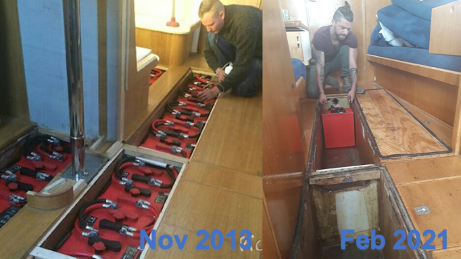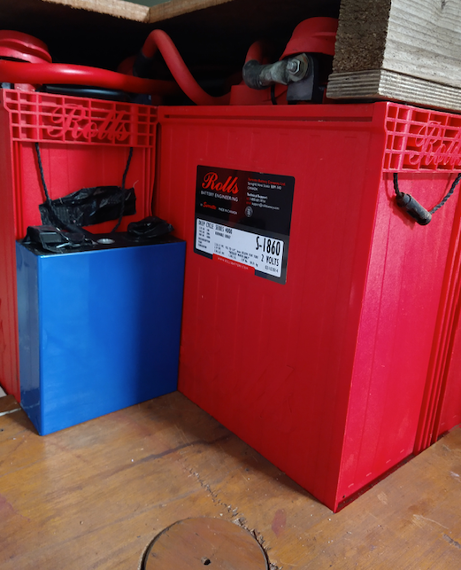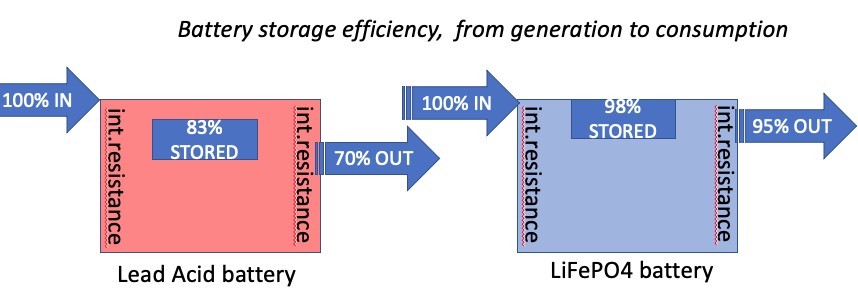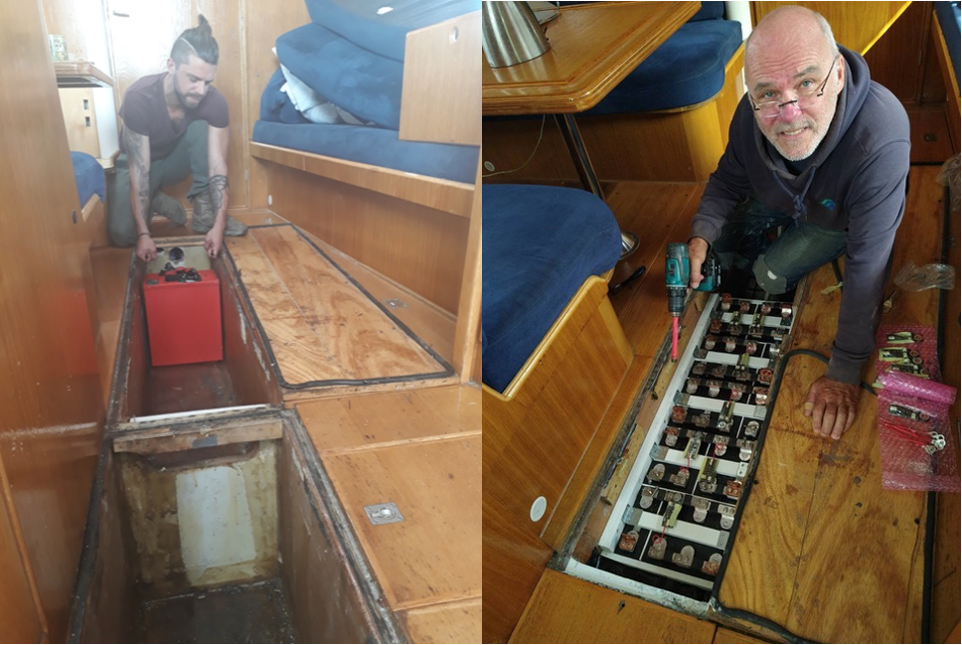This is the first of 4 articles about LFP on the Ya. This is about the why.
The Lithium Ferro Phosphate batteries (also called LiFePO4, or LFP) have so many advantages over the conventional batteries, that we recently changed our system and installed them on “Ya”.
If we could do it all over again, we would have installed them right away. Not only because they are lighter, smaller, safer, cleaner, have a higher storage efficiency, they are more durable and require less maintenance. But also, because they have the future.

LiFePO4 batteries are lighter and smaller
We replaced the 24 60 kg lead acid batteries for 48 LFP batteries. The lead acid bank was weighing 1420 kilogram, the new LFP bank weights less than 300 kg, including BMS and wiring. This is 5 times lighter.

Lithium stores the electricity more efficient and effective
A lead acid battery has resistance to take energy. It simply costs energy just to put the electricity in, for example from a charger. 15% (with new batteries) to 20% (when older) of the electricity put in, converts to heat. The charger has to ‘push’ it into the batteries. So, 80-85% of the created energy will be stored. And again, if the electricity must come out for a device, it takes another 15 (new) to 20% of electricity.
So, the storage efficiency of a lead-acid battery is 83% X 83% is about 70%.
For example, if you generate 10 kWh for your lead acid battery during the day, you will only get 7 kWh out of it in the night.
A lithium battery takes the electricity in easily and gives it just as easy to the consuming devices. There is hardly resistance, you will lose not much more than 2% to bring it in, and 2% to get it out. This makes an overall storage efficiency of up to 95%.
So if you would replace your lead acid for LFP, you could take the LFP 25% smaller and you have the same energy to consume.

Storage means: bringing it into the battery from an energy source, and getting it out to a consumer device. The energy efficiency of Lithium is 25% higher.
The storage of a Lithium battery is also more effective. The best traction lead acid batteries, can be discharged till 20%. But the Lithium Ferro Phosphate battery can go to 10%. It is 90% effective.

So, if you replace lead acid for LFP, you can buy a 25+10% = 35% smaller capacity on the effective storage of the original lead acid, and you have the same amount of energy to consume.
LFP is safer
LFP (Lithium Ferro Phosphate) is not Lithium Ion or Lithium Polymer (LiPo or LiPol). These types are used in your mobile phone, or in electric cars, and they can start burning spontaneously. The problem is even bigger, because, even when the fire is extinguished, it is self-igniting. Now, electric cars with an extinguished fire, are immediately put in a big container with water, to cool it down for days. It is weird that the governments are OK with Lithium Ion, especially in big amounts, such as in cars. Never ever put it on your ship, because at sea you can step from board only once, and there are no emergency services for a quick salvage.
With LFP on board, the battery bank can only continue burning if you keep on putting energy into it. You stop the input; it is self retarding. So, when at sea, it is safer than any other energy storage medium, such as Lithium Ion, gas, petrol, diesel, or lead acid batteries.
About the lead acid. The hydrogen coming out of open traction batteries can explode. The sulfur acid can ignite and burn on higher temperature. And the sulfur acid (H2SO4) is dangerous by itself. When a battery bursts or explodes, the damage made by this acid to its environment is gigantic.
Sustainability potential
We know that diesel, petrol and other combustives are the worst on sustainability, because all of it comes into the environment. The biggest part as CO2 causing the climate change, but also much NOx and SOx, leading to acidification.
The A brand lead acid batteries recycle between 98 and 99 %. So about 14 to 28 kilo of lead and/or sulfuric acid of our old battery bank ends up in the environment. That is a lot, because lead is a heavy metal, so very bad to the environment, and sulfuric acid is as well.
About Lithium, the best thing is that we use about 1/3 of the weight compared to lead acid. The properties show that Lithium should have the potential to create a smaller environmental impact then lead and sulfuric acid. But we don’t know yet about the environmental care taken for Lithium. These batteries are new, and the sustainability number is still unclear. (source )
LFP battery maintenance 1 minute per 3 months
The traction lead acid batteries are always open batteries, you need to add demineralized water on a regular base. The batteries need to be equalized, to keep them in good shape, every 3 months, you have some hours of work on it. Nothing compared to a diesel of petrol engine, but still.
LiFePO4 batteries have a Battery Management System taking care of all this. No refills, nothing. The only thing you do is take one minute every 3 months to push the plug of the charger into an 230 Volt outlet. The battery bank will be charged to 99%, and in the last percent the BMS will run a balancing routine. This balancing keeps them all on the same voltage level, so you don’t have the risk of overcharging or discharging one too much.
GRAPH PLUG IN OUTLET
Once in a quarter you put the charger plug in an outlet and the BMS will top up the bank and balance all cells. That’s it.
Durability
The durability of a battery means how long it lasts as an electricity storage. By using it, a battery loses a bit of its storage capacity. At the end of its life, it will use more and more electricity by itself.
The best condition for a lead acid battery (all types: traction, AGM or gel) is to keep it full, on 100%. They last long if you start an engine with it, and immediately charge it back to 100%. Like with cars. That way, the battery can even last for over 10 years.
The worst thing is, to empty it. That shortens its life dramatically. Deep cycles will also shorten the life a lot.
But its life also shortens when it is used just a bit all the time and it (hardly) ever is on its 100%.
Actually, the best is not to use a lead acid battery, or short, or sporadic.
On the Ya we oversized our battery bank in the first place, hence we prevent real deep cycles, so giving it the chance for a longer life. But, the inherent problem on Ya is that the lead acid bank was seldom fully charged, as it is the energy buffer. The meter generally showed a percentage between 60 to 90%. So, we committed a continuous light ‘abuse’ to the battery bank.
And we noticed this. Over the years, the batteries contained less and less energy. It was going down faster each year. In the seventh year, the battery bank contained effectively about 25-30 kWh instead of the original 55 kWh. It was still enough for getting us comfortably to Portugal and Spain, but we considered renewing them, because this deterioration process goes faster and faster.
Then we checked the LiFePO4 batteries, and we saw two interesting properties:
- Lithium Ferro Phosphate likes to be not full. Then they will last longer. Just what we want.
- The estimated life is generally accepted for 10 years and they would then contain 80% of their storage capacity. And from then the storage capacity will lower in a curve, just like lead acid does, and it is widely agreed that at 20 years your LFP battery should be considered dead. Like our lead acid batteries in 7 years.

Conclusion
We thought first that LFP batteries were way to expensive. But:
- The storage efficiency is 95%, versus the 70% of the lead acid. And you can discharge them till there is 10% left so an extra 10%, compared to the 20% of lead acid.
- They are lighter, smaller, inherently safer, and the environmental damage appears to be lower.
- The durability is roughly two times longer.
This 35% better storage efficiency means: you need 35% less battery capacity than for lead acid.
The double number on durability means that the price per year would be lower.
So, is Lithium Ferro Phosphate really so much more expensive? All together, we were tempted to check the prices.
Next week we show the result in a sort of business case.
sources:
https://www.instituteforenergyresearch.org/renewable/the-environmental-impact-of-lithium-batteries/?cf_chl_captcha_tk=pmd_UzmpBeaklu64YJSZjEHNitDOqdXlTcPUQuhTxJrCGtM-1635934800-0-gqNtZGzNAyWjcnBszQiR )
https://www.sciencedirect.com/topics/engineering/ah-efficiency
Any comments? Please mail us: info@fossilfreearoundtheworld.org

